2020 MERCEDES-BENZ GLA tire pressure
[x] Cancel search: tire pressurePage 27 of 346
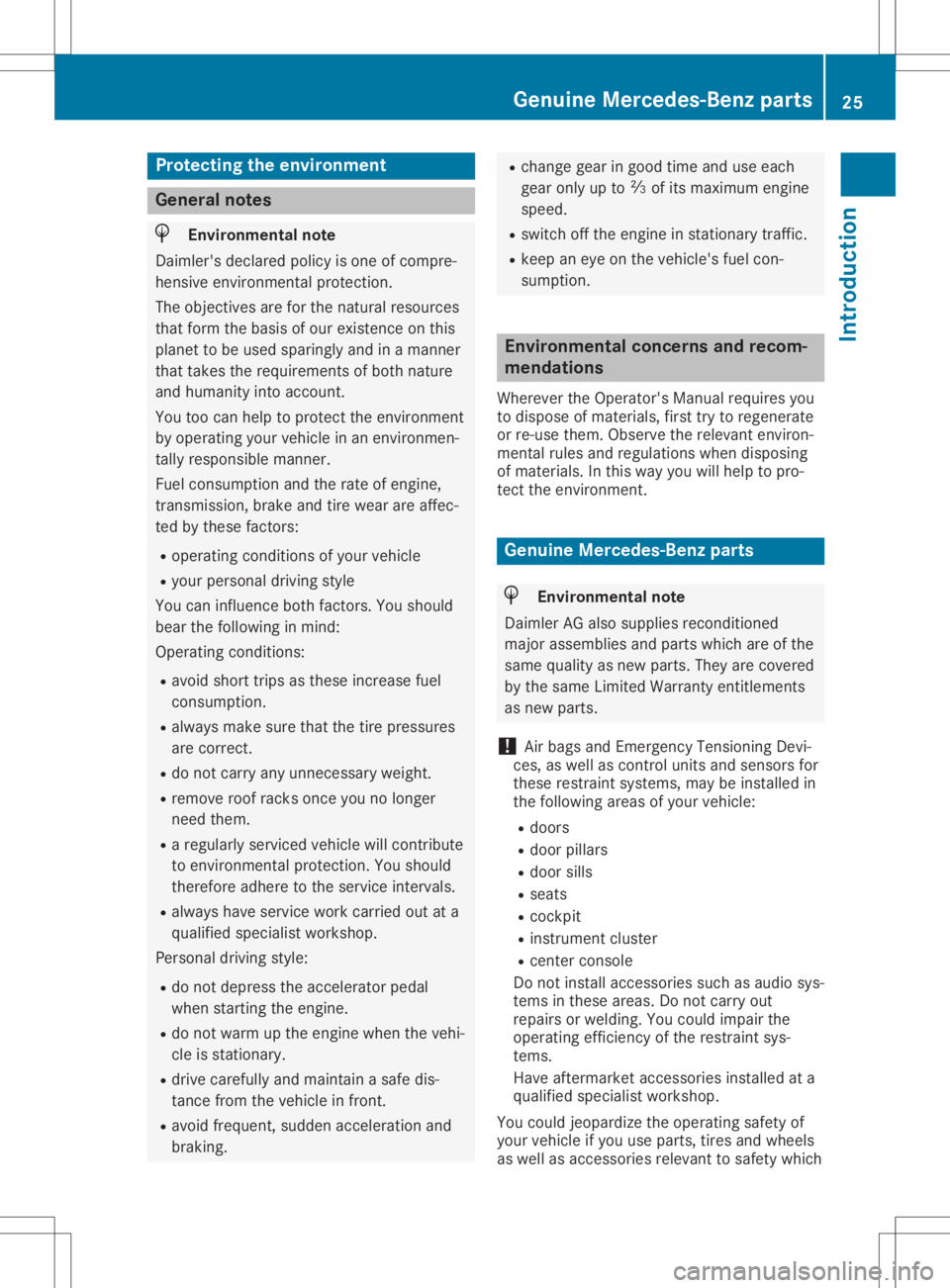
Protecting
theenvironment General
notes H
Environmental
note
Daimler's declaredpolicyisone ofcompre-
hensive environm entalprotect ion.
The object ivesareforthe natural resources
that form thebasis ofour existen ceon this
planet tobe used sparingly andinamanner
that takes therequirements ofboth nature
and humanity intoaccount.
You toocan help toprotect theenvironm ent
by operating yourvehicle inan environm en-
tally responsible manner.
Fuel consumpt ionand therate ofengine,
transm ission,brakeandtirewear areaffec-
ted bythese factors:
R operating conditionsof your vehicle
R your personal drivingstyle
You caninfluence bothfactors. Youshould
bear thefollowing inmind:
Operating conditions:
R avoid shorttripsasthese increase fuel
consumpt ion.
R alwa ysmake surethatthetire pressures
are correct .
R do not carry anyunnecessary weight.
R remove roofracks onceyounolonger
need them.
R aregularly servicedvehiclewillcont ribute
to environm entalprotect ion.You should
therefore adheretothe service intervals.
R alwa yshave service workcarried outata
quali fiedspecialist workshop.
Personal drivingstyle:
R do not depress theaccelerator pedal
when startin gthe engine.
R do not warm upthe engine whenthevehi-
cle isstationary.
R drive carefully andmaintain asafe dis-
tance fromthevehicle infront .
R avoid frequent, suddenacceleration and
braking. R
change gearingood timeanduseeach
gear onlyupto00C3 ofits maximum engine
speed.
R switch offthe engine instationary traffic.
R keep aneye onthe vehicle's fuelcon-
sumption. Environmental
concerns andrecom-
mendat ions
Wherever theOperator's Manualrequires you
to dispose ofmaterials, firsttrytoregenerate
or re-use them.Observe therelevant environ-
ment alrules andregulations whendisposing
of materials. Inthis way youwillhelp topro-
tect theenvironm ent. Genuine
Mercedes-Benz parts H
Environmental
note
Daimler AGalso supplie srecondit ioned
major assemblies andparts which areofthe
same qualityas new parts. Theyarecovered
by the same Limited Warranty entitlements
as new parts.
! Air
bags andEmergen cyTensioning Devi-
ces, aswell ascont rolunits andsensors for
these restraint systems, maybeinstalled in
the following areasofyour vehicle:
R doors
R door pillars
R door sills
R seats
R cock pit
R instrumen tcluster
R cent erconsole
Do not install accessories suchasaudio sys-
tems inthese areas. Donot carry out
repairs orwelding. Youcould impair the
operating efficiency ofthe restraint sys-
tems.
Have aftermark etaccessories installedata
quali fiedspecialist workshop.
You could jeopardize theoperating safetyof
your vehicle ifyou useparts, tiresandwheels
as well asaccessories relevanttosafety which Genuine
Mercedes-Benz parts
25Introdu ction Z
Page 65 of 346
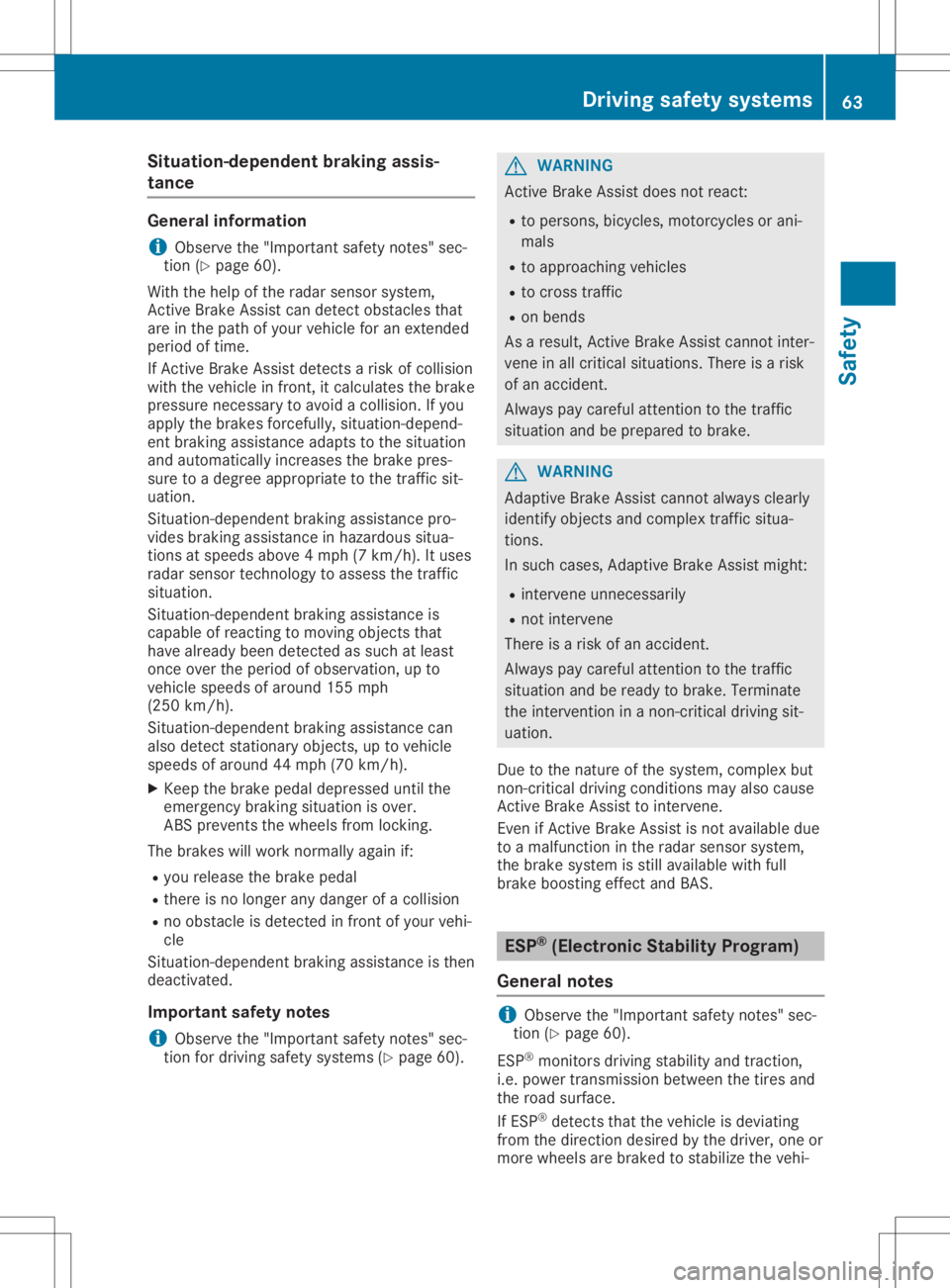
Situat
ion-dependent brakingassis-
tance General
informat ion
i Observe
the"Important safetynotes" sec-
tion (Ypage 60).
With thehelp ofthe radar sensor system,
Act ive Brake Assist candetect obstacles that
are inthe path ofyour vehicle foranexten ded
period oftime.
If Act ive Brake Assist detectsa risk ofcollision
with thevehicle infront ,it calculates thebrake
pressure necessary toavoid acollision. Ifyou
apply thebrakes forcefully, <0056004C0057005800440057004C005200510010004700480053004800510047
0010[
ent braking assistance adaptstothe situation
and automatically increasesthebrake pres-
sure toadegree appropriate tothe traffic sit-
uation.
Situation- dependent brakingassistance pro-
vides braking assistance inhazardous situa-
tions atspeeds above4mph (7km/h). Ituses
radar sensor technology toassess thetraffic
situation.
Situation- dependent brakingassistance is
capable ofreacting tomoving objectsthat
have already beendetect edassuch atleast
once overtheperiod ofobservation, upto
vehicle speeds ofaround 155mph
(250 km/h).
Situation- dependent brakingassistance can
also detect stationary objects,up tovehicle
speeds ofaround 44mph (70km/h).
X Keep thebrake pedaldepressed untilthe
emergency brakingsituation isover.
ABS prevent sthe wheels fromlocking.
The brakes willwork normally againif:
R you release thebrake pedal
R there isno longer anydanger ofacollision
R no obstacle isdetect edinfront ofyour vehi-
cle
Situation- dependent brakingassistance isthen
deactivated.
Import antsafety notes
i Observe
the"Important safetynotes" sec-
tion fordriving safetysystems (Ypage 60). G
WARNING
Act ive Brake Assist doesnotreact:
R to persons, bicycles, motorcyclesorani-
mals
R to approaching vehicles
R to cross traffic
R on bends
As aresult, Active Brake Assist cannot inter-
vene inall critical situations. Thereisarisk
of an accident.
Always paycareful attentiontothe traffic
situation andbeprepared tobrake. G
WARNING
Adaptive BrakeAssist cannot alwaysclearly
identify objectsand complex trafficsitua-
tions.
In such cases, Adaptive BrakeAssist might:
R interv eneunnecessarily
R not interv ene
There isarisk ofan accident.
Always paycareful attentiontothe traffic
situation andbeready tobrake. Terminate
the interv ention inanon- critical drivingsit-
uation.
Due tothe nature ofthe system, complex but
non- critical drivingcondition smay alsocause
Act ive Brake Assist tointerv ene.
Even ifAct ive Brake Assist isnot availa bledue
to amalfunction inthe radar sensor system,
the brake system isstill availa blewith full
brake boosting effectandBAS. ESP
®
(Ele ctronic Stability Program)
General notes i
Observe
the"Important safetynotes" sec-
tion (Ypage 60).
ESP ®
monitor sdriving stability andtract ion,
i.e. power transm issionbetween thetires and
the road surface.
If ESP ®
detect sthat thevehicle isdeviating
from thedirection desiredbythe driver, oneor
more wheels arebraked tostabilize thevehi- Driving
safetysystems
63Safety Z
Page 146 of 346
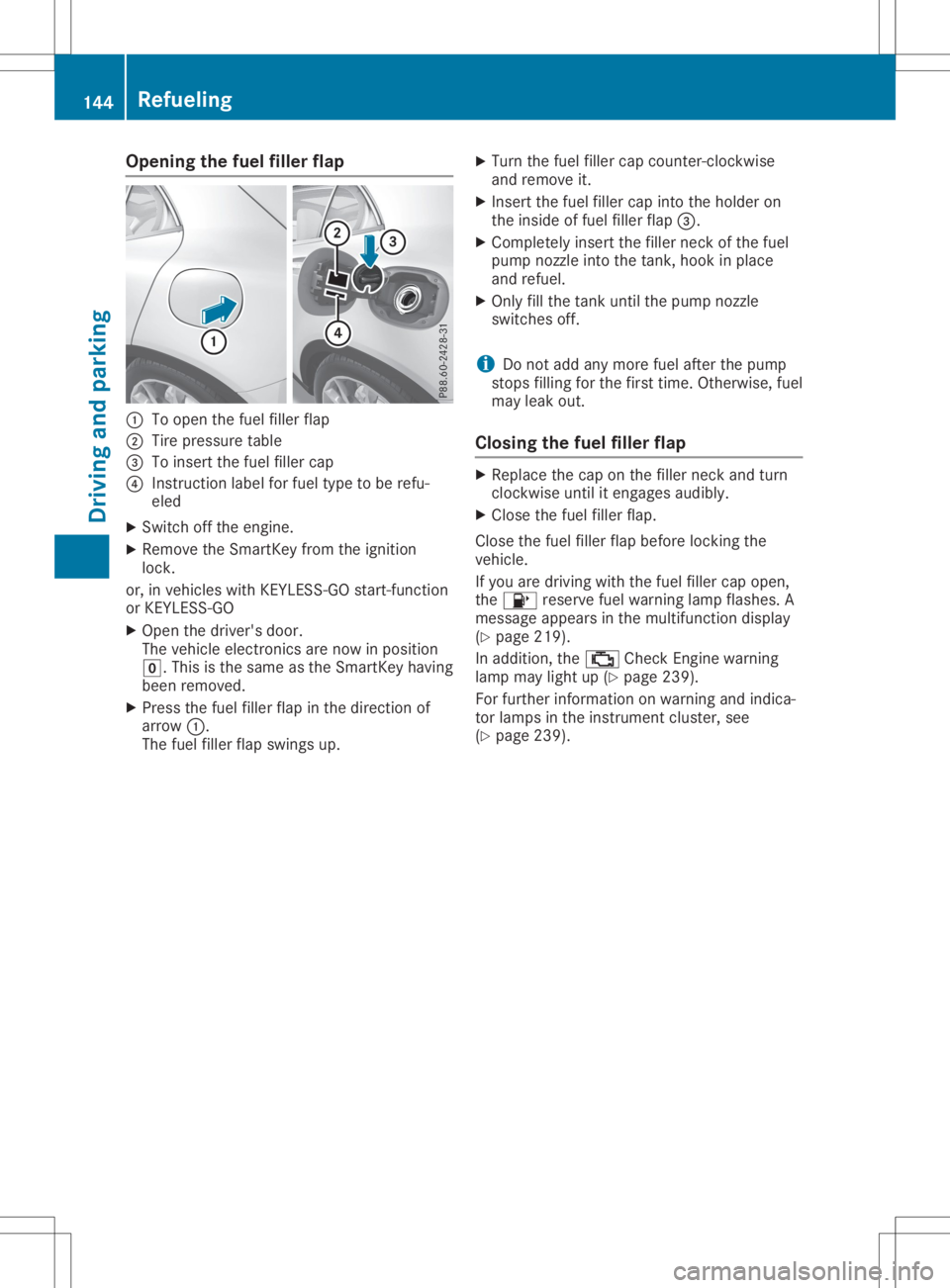
Opening
thefuel filler flap 0043
Toopen thefuel filler flap
0044 Tire pressure table
0087 Toinsert thefuel filler cap
0085 Instruct ionlabel forfuel type tobe refu-
eled
X Switc hoff the engine .
X Remove theSmart Keyfrom theignition
lock.
or, invehicles withKEYLE SS-GO start -function
or KEYLE SS‑GO
X Open thedriver's door.
The vehicle electronics arenow inposition
005A. This isthe same asthe Smart Keyhaving
been removed.
X Press thefuel filler flapinthe direct ionof
arrow 0043.
The fuel filler flapswings up. X
Turn thefuel filler capcount er-clockwise
and remove it.
X Inser tthe fuel filler capinto theholder on
the inside offuel filler flap0087.
X Completely insertthefiller neck ofthe fuel
pump nozzleinto thetank ,hook inplace
and refuel.
X Only fillthe tank untilthepump nozzle
switches off.
i Do
not add anymore fuelafter thepump
stops fillingforthe first time. Otherwise, fuel
may leakout.
Closing thefuel filler flap X
Replace thecap onthe filler neck andturn
clock wiseuntilitengages audibly.
X Close thefuel filler flap.
Close thefuel filler flapbefore lockingthe
vehicle.
If you aredriving withthefuel filler capopen,
the 00B6 reserv efuel warning lampflashes. A
message appearsinthe multifunc tiondisplay
(Y page 219).
In addition, the00B9 Check Engine warning
lamp maylight up(Ypage 239).
For furth erinfor mation onwarning andindica-
tor lamps inthe instrument cluster,see
(Y page 239). 144
RefuelingDriving
andparking
Page 152 of 346
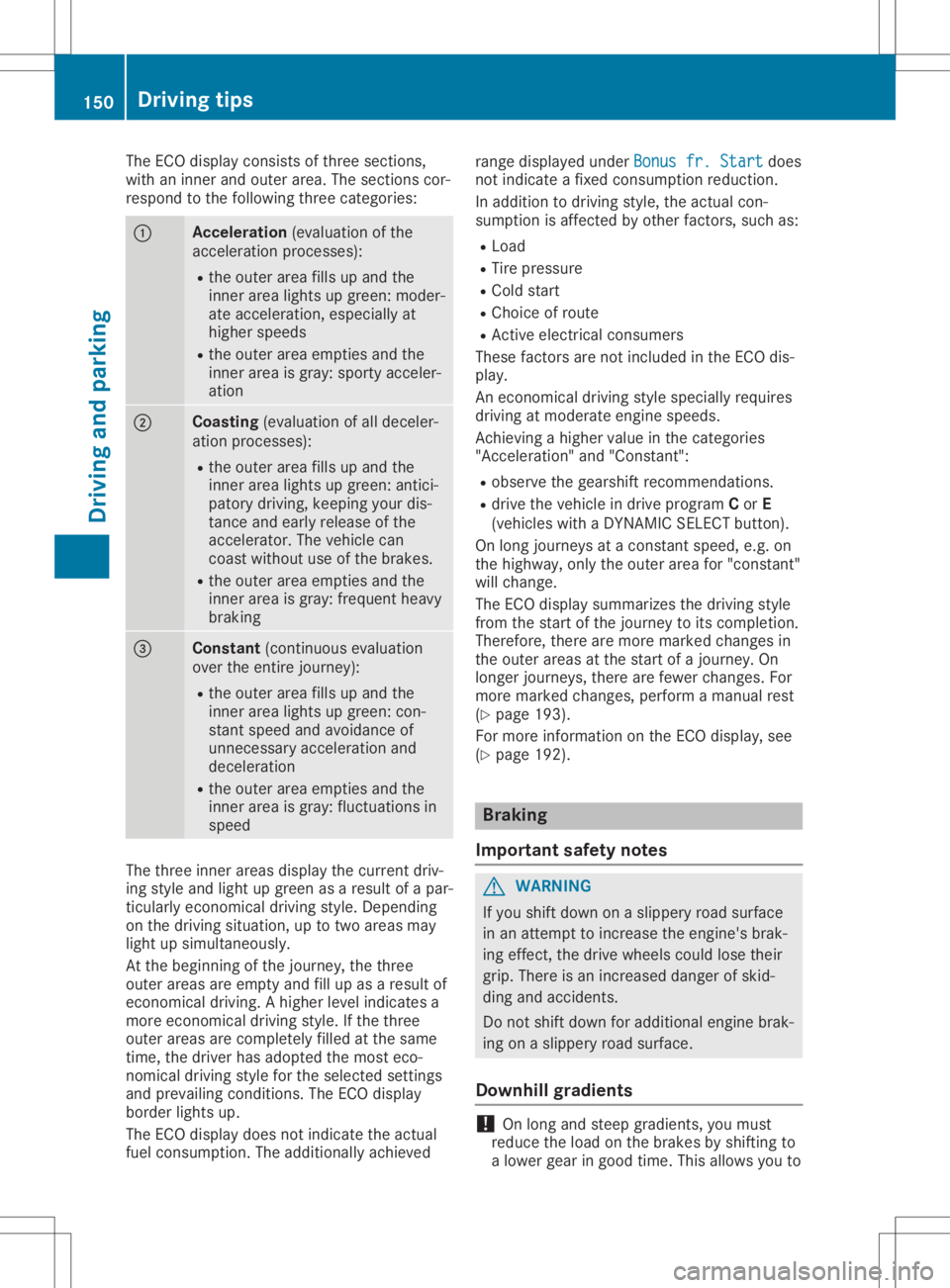
The
ECO display consistsof three section s,
with aninner andouter area.Thesection scor-
respond tothe following threecategories: 0043
Acce
leration (evaluation ofthe
acceleration processes):
R the outer areafillsupand the
inner arealights upgreen: moder-
ate acceleration ,especially at
higher speeds
R the outer areaempties andthe
inner areaisgray: sporty acceler-
ation 0044
Coasting
(evaluation ofall deceler-
ation processes):
R the outer areafillsupand the
inner arealights upgreen: antici-
patory driving, keeping yourdis-
tanc eand early release ofthe
accelerator. Thevehicle can
coast without useofthe brakes.
R the outer areaempties andthe
inner areaisgray: frequent heavy
braking 0087
Constant
(continuous evaluation
over theentir ejourney):
R the outer areafillsupand the
inner arealights upgreen: con-
stant speed andavoidance of
unnec essary acceleration and
deceleration
R the outer areaempties andthe
inner areaisgray: fluctuations in
speed The
three innerareas display thecurrent driv-
ing style andlight upgreen asaresult ofapar-
ticularly economicaldriving style.Dependin g
on the driving situation, uptotwo areas may
light upsimultaneously.
At the beginning ofthe journey, thethree
outer areas areempty andfillup asaresult of
econom icaldriving. Ahigher levelindicates a
more econom icaldriving style.Ifthe three
outer areas arecompletely filledatthe same
time, thedriver hasadopted themost eco-
nomical drivingstyleforthe selected settings
and prevailing conditions.TheECO display
border lightsup.
The ECO display doesnotindicate theactual
fuel consumpt ion.Theadditionally achieved range
display edunder Bonus fr.Start Bonus
fr.Start does
not indicate afixed consumpt ionreduction .
In addition todriving style,theactual con-
sumption isaffect edbyother factors,such as:
R Load
R Tire pressure
R Cold start
R Choice ofroute
R Act ive electric alconsumer s
These factorsare not included inthe ECO dis-
play.
An econom icaldriving stylespecially requires
driving atmoderate enginespeeds.
Achievin gahigher valueinthe categories
"Accelerat ion"and"Constant ":
R observe thegearshift recommendations .
R drive thevehicle indrive program Cor E
(vehicles withaDYNA MICSELECT button ).
On long journeys ataconst antspeed, e.g.on
the highway, onlytheouter areafor"const ant"
will change.
The ECO display summarizes thedriving style
from thestart ofthe journey toits completion .
Therefore, therearemore marked changes in
the outer areas atthe start ofajourney. On
longer journeys, therearefewer changes. For
more marked changes, performamanual rest
(Y page 193).
For more inform ationonthe ECO display ,see
(Y page 192). Br
aking
Import antsafety notes G
WARNIN
G
If you shift down onaslippery roadsurface
in an attempt toincrease theengine's brak-
ing effect ,the drive wheels couldlosetheir
grip. There isan increased dangerofskid-
ding andaccident s.
Do not shift down foradditional enginebrak-
ing onaslippery roadsurface.
Dow nhill gradients !
On
long andsteep gradients, youmust
reduce theload onthe brakes byshiftin gto
a lower gearingood time. Thisallows youto 150
Driving
tipsDriving andparking
Page 177 of 346
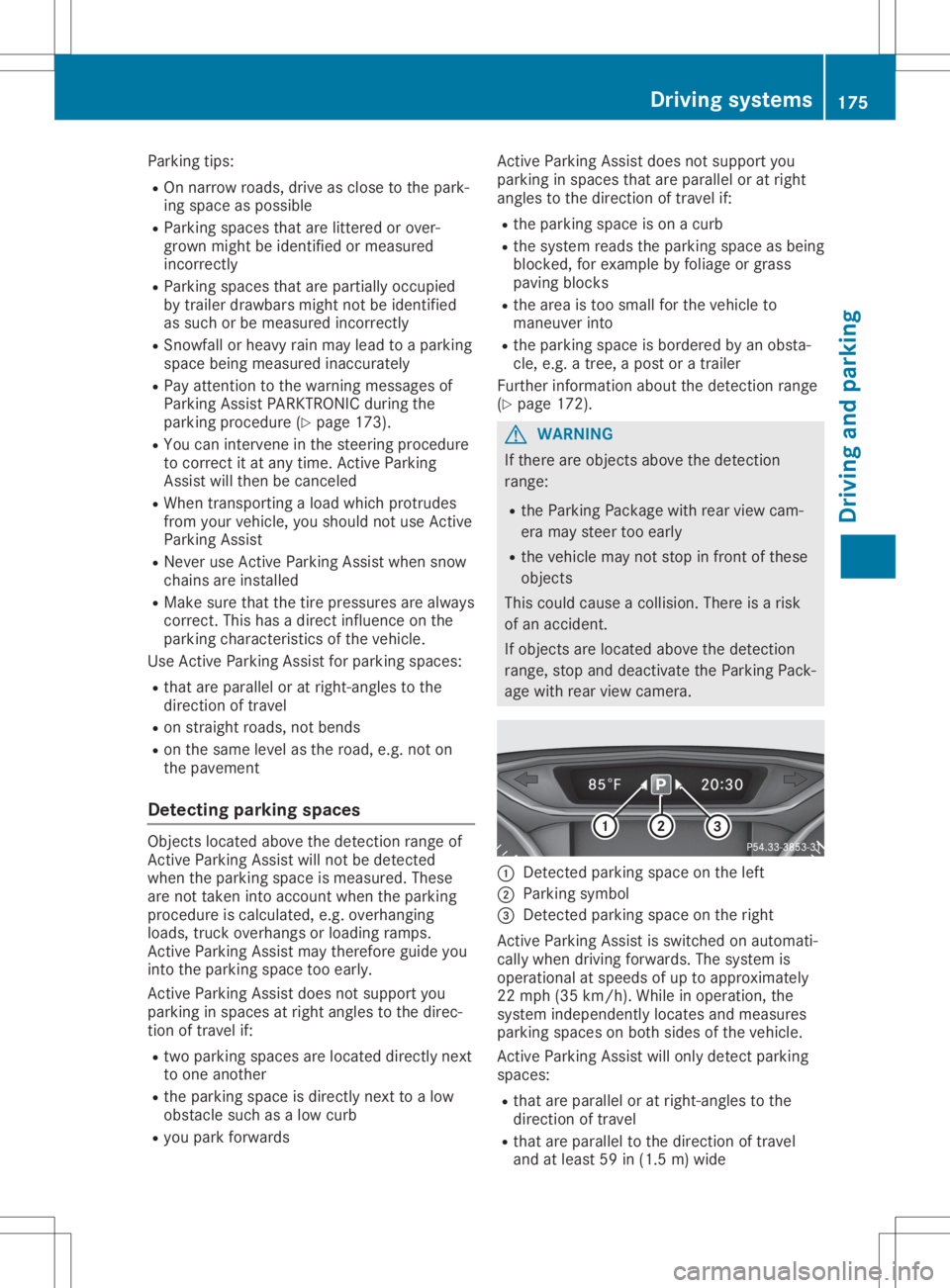
Parking
tips:
R On narrow roads,driveasclose tothe park-
ing space aspossible
R Parking spacesthatarelittered orover-
grown mightbeidentified ormeasured
incor rectly
R Parking spacesthatarepartially occupied
by trailer drawbars mightnotbeidentified
as such orbe measured incorrectly
R Snowf allorheavy rainmay lead toaparking
space beingmeasured inaccurately
R Pay atten tiontothe warning messages of
Parking AssistPARKTRONIC duringthe
parking procedure (Ypage 173).
R You caninter vene inthe steerin gprocedure
to correc tit at any time. Active Parking
Assist willthen becanc eled
R When transportin gaload which protrudes
from yourvehicle, youshould notuse Active
Parking Assist
R Never useActive Parking Assistwhensnow
chains areinstalled
R Make surethatthetire pressures arealway s
correc t.This hasadirect influenc eon the
parking characteristics ofthe vehicle.
Use Active Parking Assistforparking spaces:
R that areparallel oratright- angles tothe
direction oftravel
R on straight roads,notbends
R on the same levelasthe road, e.g.noton
the pavement
Detecting parking spaces Object
slocated abovethedetect ionrange of
Act ive Parking Assistwillnotbedetect ed
when theparking spaceismeasured. These
are not taken intoaccount whentheparking
procedure iscalculated, e.g.overhangin g
loads, truckoverhangs orloading ramps.
Act ive Parking Assistmaytheref oreguide you
into theparking spacetooearly.
Act ive Parking Assistdoesnotsupport you
parking inspaces atright angles tothe direc-
tion oftravel if:
R two parking spacesarelocated directly next
to one another
R the parking spaceisdirectly nexttoalow
obstacle suchasalow curb
R you park forwards Act
ive Parking Assistdoesnotsupport you
parking inspaces thatareparallel oratright
angles tothe direction oftravel if:
R the parking spaceison acurb
R the system readstheparking spaceasbeing
blocked, forexample byfoliage orgrass
paving blocks
R the area istoo small forthe vehicle to
maneuver into
R the parking spaceisbordered byan obsta-
cle, e.g. atree, apost oratrailer
Further informationabout thedetect ionrange
(Y page 172). G
WARNIN
G
If there areobject sabove thedetect ion
range:
R the Parking Package withrearview cam-
era may steer tooearly
R the vehicle maynotstop infron tof these
object s
This could cause acollision. Thereisarisk
of an accident .
If object sare located abovethedetect ion
range, stopanddeactivate theParking Pack-
age with rearview camera. 0043
Detected parking spaceonthe left
0044 Parking symbol
0087 Detected parking spaceonthe right
Act ive Parking Assistisswitched onautomati-
cally when driving forwards. Thesystem is
operational atspeeds ofup toapproximately
22 mph (35km/ h).Whi lein ope ration, the
sy stem indepe ndentl ylo cate sand measures
pa rking spaces onboth sides ofthe vehicle.
Active Parking Assistwillonly detectparking
spa ces:
R that areparal lelor atright-ang lesto the
di recti onoftrav el
R that areparal lelto the directi onoftrav el
and atleas t59 in(1.5 m)wid e Dr
ivin gsy stem s
175Dr ivin gand parking Z
Page 293 of 346
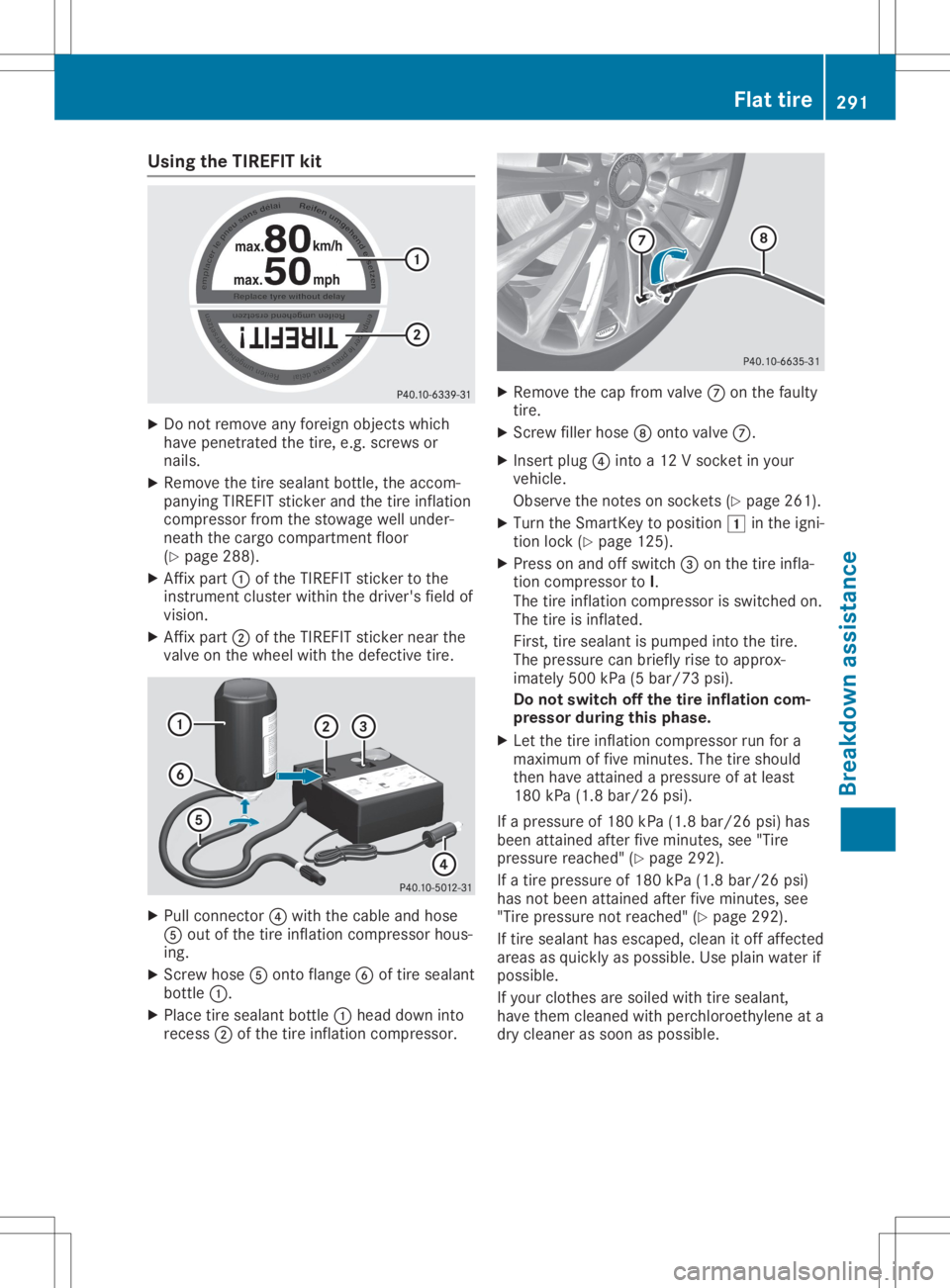
Using
theTIREFIT kit X
Do not remov eany foreign objectswhich
have penet rated thetire, e.g.screws or
nails.
X Remove thetire sealant bottle,the accom -
panying TIREFITstic ker and thetire inflat ion
compr essorfromthestowage wellunder-
neat hthe cargo compar tmentfloor
(Y page 288).
X Aff ixpart 0043ofthe TIREF ITstic ker tothe
inst rumen tclust erwithin thedriver' sfield of
vision .
X Aff ixpart 0044ofthe TIREF ITstic ker near the
valve onthe wheel withthedefect ivetire. X
Pull connector0085with thecable andhose
0083 out ofthe tire inflat ioncompr essorhous-
ing.
X Sc rew hose 0083ontoflange 0084oftire sealant
bott le0043.
X Place tiresealant bottle0043 head down into
reces s0044 ofthe tire inflat ioncompr essor. X
Remove thecap from valve 006Bonthe faulty
tire.
X Sc rew filler hose 006Contovalve 006B.
X Ins ert plug 0085intoa12 Vsock etinyour
vehicle.
Observ ethe noteson sock ets(Ypage 261).
X Turn theSmart Keytoposition 0047inthe igni-
tion lock (Ypage 125).
X Press onand offswitc h0087 onthe tire infla-
tion compr essortoI.
The tireinflat ioncompr essorisswitc hedon.
The tireisinflat ed.
First ,tire sealant ispumped intothe tire.
The pressure canbriefly risetoapprox-
imately 500kPa(5bar/7 3psi).
Do not switch offthe tireinflat ioncom-
pr essor during this phase.
X Let the tire inflat ioncompr essorrunfora
maximum offive minut es.The tireshould
then have attained apressure ofat least
180 kPa(1.8 bar/2 6psi).
If apressure of180 kPa(1.8 bar/26 psi)has
been attained afterfiveminut es,see "Tire
pressure reached" (Ypage 292).
If atire pressure of180 kPa(1.8 bar/26 psi)
has notbeen attained afterfiveminut es,see
"Tire pressure notreached" (Ypage 292).
If tire sealant hasescaped, cleanitoff affec ted
areas asquickly aspossible. Useplain water if
possible.
If your clothes aresoiled withtiresealant ,
have them cleaned withperch loroet hylene ata
dry cleaner assoon aspossible. Flat
tire
291Breakd ownassist ance Z
Page 310 of 346
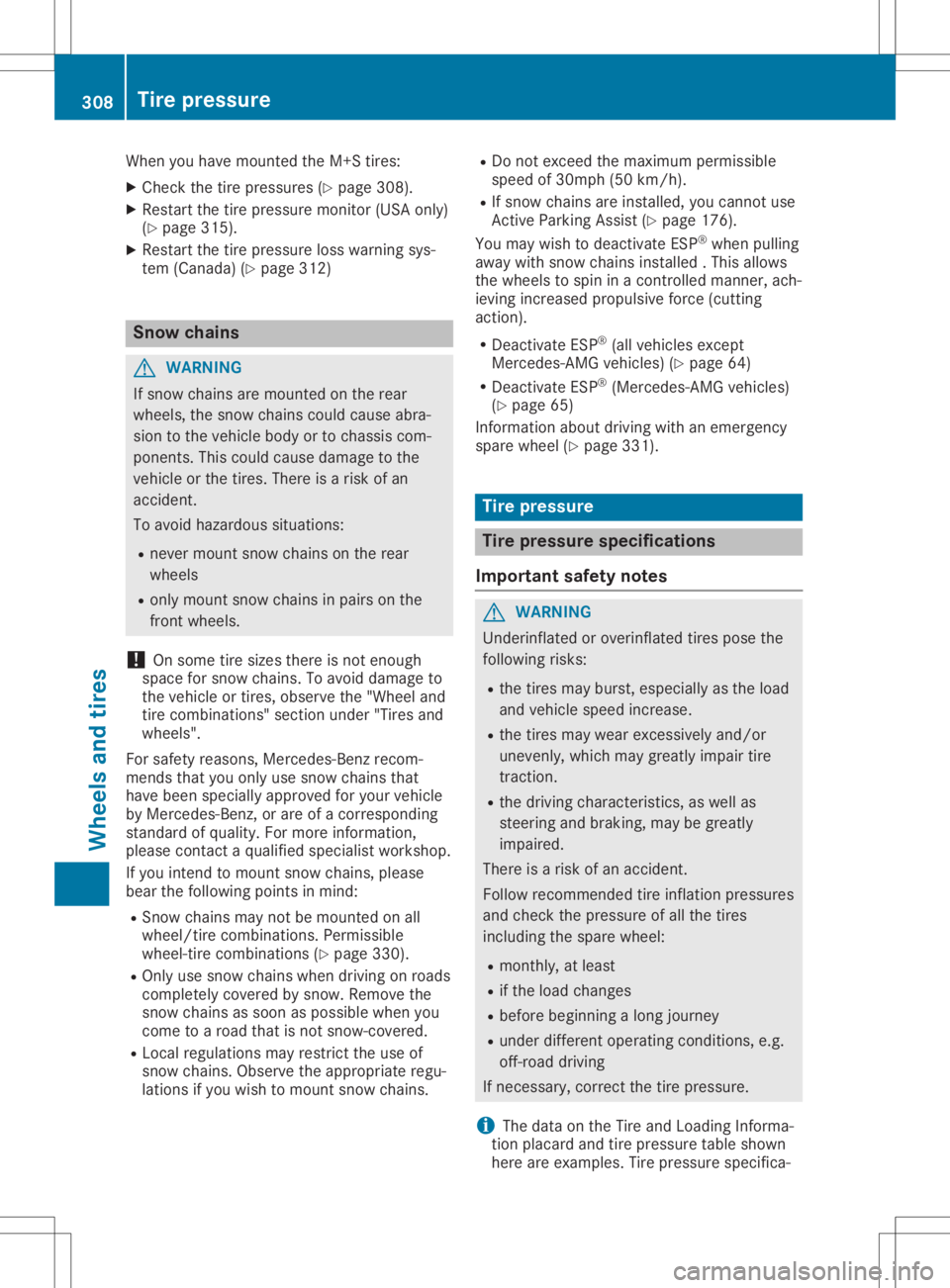
When
youhave mount edthe M+S tires:
X Check thetire pressures (Ypage 308).
X Restart thetire pressure monitor(USA only)
(Y page 315).
X Restart thetire pressure losswarning sys-
tem (Canada) (Ypage 312) Snow
chains G
WARNIN
G
If snow chains aremount edon the rear
wheels, thesnow chains couldcause abra-
sion tothe vehicle bodyortochassis com-
ponen ts.This could cause damage tothe
vehicle orthe tires. There isarisk ofan
accident .
To avoid hazardous situations:
R never mount snowchains onthe rear
wheels
R only mount snowchains inpairs onthe
fron twheels.
! On
some tiresizes there isnot enough
space forsnow chains. Toavoid damage to
the vehicle ortires, observe the"Wheel and
tire combin ations" sectionunder "Tiresand
wheels".
For safety reasons, Mercedes- Benzrecom-
mends thatyouonly usesnow chains that
have been specially approved foryour vehicle
by Mercedes- Benz,or are ofacorr esponding
standard ofquality. Formore inform ation,
please contactaqualified specialist workshop.
If you inten dto mount snowchains, please
bear thefollowing pointsinmind:
R Sno wchains maynotbemount edon all
wheel/tire combinations.Permissible
wheel-tire combinations(Ypage 330).
R Only usesnow chains whendriving onroads
complet elycovered bysnow. Remove the
snow chains assoon aspossible whenyou
come toaroad thatisnot snow-c overed.
R Local regulations mayrestrictthe use of
snow chains. Observe theappropriate regu-
lations ifyou wish tomount snowchains. R
Do not exceed themaximum permissible
speed of30mph (50km/ h).
R Ifsnow chains areinstalled, youcann otuse
Act ive Parking Assist(Ypage 176).
You may wish todeactivat eES P®
when pulling
away withsnow chains installed .This allows
the wheels tospin inacont rolled manner,ach-
ieving increased propulsive force(cutt ing
action ).
R Deact ivateESP®
(all vehicles except
Mercedes- AMGvehicles) (Ypage 64)
R Deact ivateESP®
(Mercedes- AMGvehicles)
(Y page 65)
Inf ormation aboutdriving withanemergen cy
spare wheel (Ypage 331). Tir
epr essure Tir
epr essure specifications
Impor tantsafety notes G
WARNIN
G
Underin flatedoroverinf latedtirespose the
following risks:
R the tires mayburst, especially asthe load
and vehicle speedincrease.
R the tires maywear exces sively and/or
unevenly, whichmaygreatly impairtire
trac tion.
R the driving charact eristics,as well as
steerin gand braking, maybegreatly
impaired.
There isarisk ofan accident .
Follow recomm endedtireinflation pressures
and check thepressure ofall the tires
including thespare wheel:
R mont hly,atleast
R ifthe load changes
R before beginnin galong journ ey
R under differen toperating conditions,e.g.
off- road driving
If neces sary,correctthe tire pressure.
i The
data onthe Tire andLoading Informa-
tion placard andtirepressure tableshown
here areexamples. Tirepressure specifica- 308
Tir
epr essureWheels andtires
Page 312 of 346
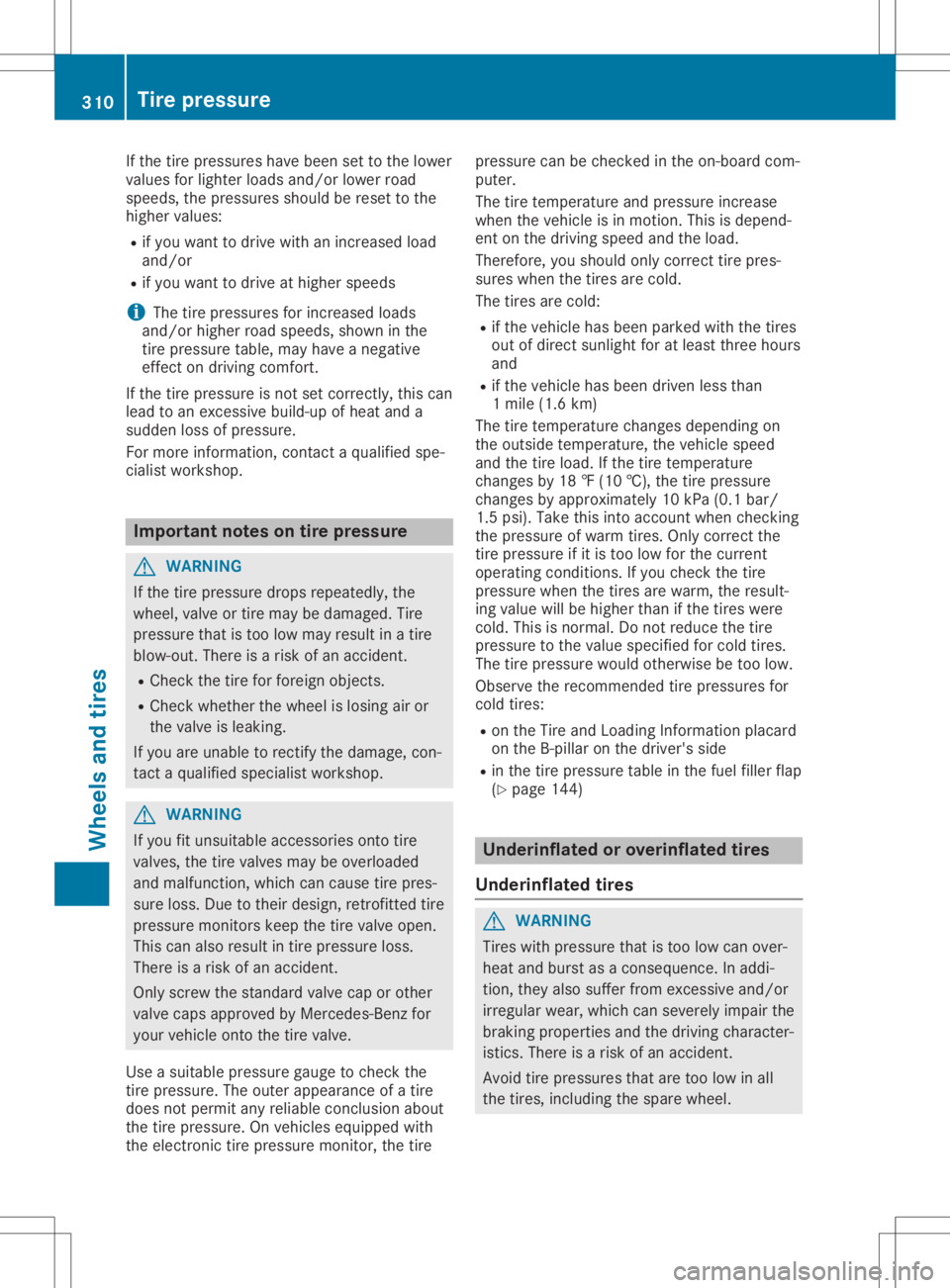
If
the tire pressu reshave been settothe lowe r
valu esfor lighter loadsand/or lowerroad
speed s,the pressu resshoul dbe reset tothe
higher values:
R ifyou want todrive withanincreased load
and/or
R ifyou want todrive athigher speeds
i The
tirepressu resforincreased loads
and/or higherroadspeed s,shown inthe
tire pressu retable, mayhave anegative
effect ondriving comfort.
If the tire pressu reisnot setcorrectly, thiscan
lea dto an excessive build-up ofheat anda
sudd enloss ofpressu re.
For more information, contactaqua lifiedspe-
ciali stworkshop. Important
notesontire pressure G
WARNING
If the tire pressu redrops repeatedly,the
wheel ,valve ortire may bedama ged.Tire
pressu rethat istoo low may resul tin atire
blow -out. There isarisk ofan accident.
R Check thetire forforeign objects.
R Check whether thewheel islosing airor
the valve islea king.
If you areunabl eto rectify thedama ge,con-
tact aqua lifiedspecia listworkshop. G
WARNING
If you fitunsui table accessorie sonto tire
valves ,the tire valves maybeoverloa ded
and malfu nction, whichcancause tirepres-
sure loss. Duetotheir desig n,retrofitted tire
pressu remonitors keepthetire valve open.
This canalso resul tin tire pressu reloss.
There isarisk ofan accident.
Only screw thestandard valvecaporother
valve capsappro vedbyMercedes-Benz for
you rvehicle ontothetire valve.
Use asuita blepressu regau getocheck the
tire pressu re.The outer appearance ofatire
does notpermit anyrelia bleconclusion about
the tire pressu re.On vehicle sequi pped with
the electronic tirepressu remonitor, thetire pressu
recan bechecked inthe on-board com-
puter.
The tiretemperature andpressu reincrease
when thevehicle isin motion. Thisisdepend-
ent onthe driving speedandtheload .
Therefore, youshoul donly correct tirepres-
sures whenthetires arecold.
The tires arecold:
R ifthe vehicle hasbeen parked withthetires
out ofdirect sunlightfor atlea stthree hours
and
R ifthe vehicle hasbeen driven lessthan
1 mile (1.6km)
The tiretemperature changesdependingon
the outsid etemperature ,the vehicle speed
and thetire load .If the tire temperature
changes by18 ‡(10 †), thetire pressu re
changes byappro ximately 10kPa (0.1 bar/
1.5 psi).Take thisinto account whenchecking
the pressu reofwarm tires.Onlycorrect the
tire pressu reifit is too low forthe current
opera tingconditions. Ifyou check thetire
pressu rewhen thetires arewarm, theresul t-
ing valu ewil lbe highe rthan ifthe tires were
cold. Thisisnormal. Donot reduce thetire
pressu reto the valu especifie dfor cold tires.
The tirepressu rewou ldotherwise betoo low.
Observe therecommended tirepressu resfor
cold tires:
R on the Tire andLoadi ngInformation placard
on the B-pilla ron the driver's side
R in the tire pressu retable inthe fuel fillerflap
(Y page 144) Underinfl
atedoroverin flated tires
Underinfl atedtires G
WARNING
Tires withpressu rethat istoo low can over-
heat andburst asaconsequence. Inaddi -
tion, theyalsosuffer fromexcessive and/or
irregu larwea r,which canseverel yimpa irthe
braking propertie sand thedriving character-
istics. Thereisarisk ofan accident.
Avoid tirepressu resthat aretoo low inall
the tires, includi ngthe spare wheel. 310
Tire
pressureWheel sand tires